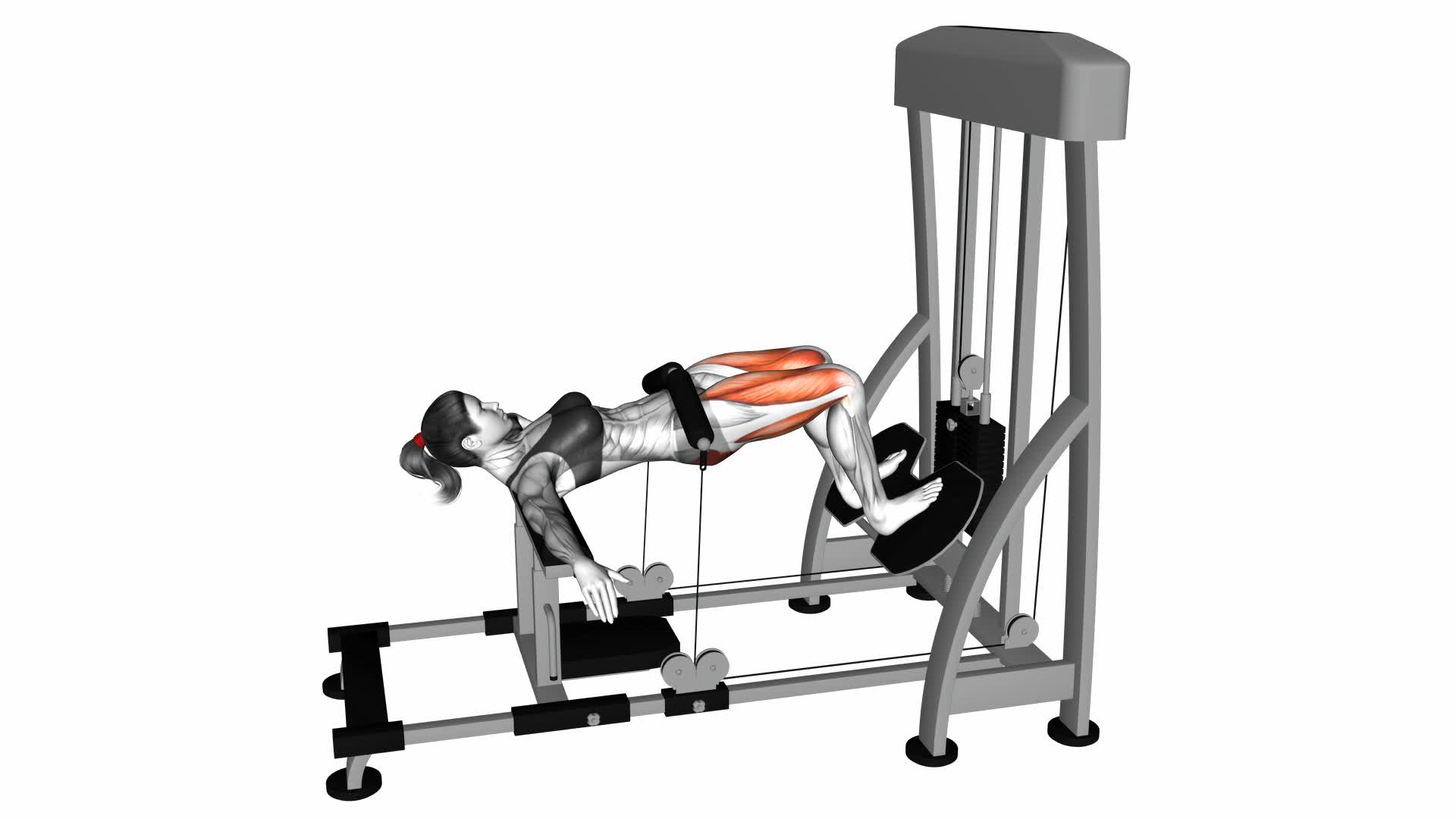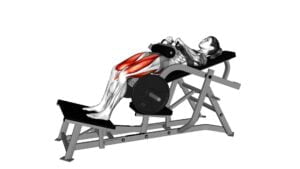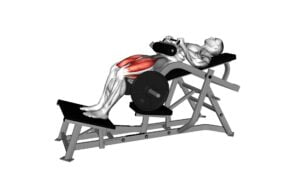Lever Hip Thrust – Video Exercise Guide & Tips

Looking to strengthen and tone your glutes?
Watch This Exercise Video
The Lever Hip Thrust is a powerful exercise that targets your hip muscles, giving you a firmer and more sculpted backside.
In this video exercise guide, we'll show you the proper form and technique for performing the Lever Hip Thrust, as well as variations and progressions to challenge yourself.
Avoid common mistakes and maximize your results with our expert tips.
Get ready to transform your booty with this effective workout.
Key Takeaways
- Lever Hip Thrust targets hip muscles for a firmer and more sculpted backside.
- It provides excellent muscle activation and increased glute strength.
- Lever Hip Thrust specifically targets the gluteus maximus, the largest muscle in the buttocks.
- It improves lower body strength and stability and enhances athletic performance while reducing the risk of injury.
Benefits of the Lever Hip Thrust
To maximize the effectiveness of your workout, you should understand the benefits of incorporating the lever hip thrust into your exercise routine.
The lever hip thrust is a powerful exercise that targets your glute muscles, providing excellent muscle activation and increased glute strength.
When performing the lever hip thrust, your glutes are the primary muscles being activated. This exercise specifically targets the gluteus maximus, which is the largest muscle in your buttocks. By focusing on this muscle group, you can effectively develop and strengthen your glutes.
Increased glute strength is one of the key benefits of incorporating the lever hip thrust into your routine. Strong glutes aren't only aesthetically pleasing but also important for overall lower body strength and stability. Your glutes play a crucial role in movements like running, jumping, and squatting. By strengthening your glutes, you can improve your athletic performance and reduce the risk of injury.
Understanding the benefits of the lever hip thrust sets the foundation for proper form and technique, which will be discussed in the subsequent section.
Proper Form and Technique
Mastering proper form and technique is essential for maximizing the effectiveness of the lever hip thrust exercise. To perform the lever hip thrust correctly, begin by positioning yourself on the lever machine with your upper back resting against the pad and your feet flat on the foot platform. Make sure your knees are bent at a 90-degree angle and your feet are hip-width apart. Place your hands on the handles for stability.
One common misconception about the lever hip thrust is that you need to arch your back excessively. However, this can lead to lower back strain. Instead, focus on maintaining a neutral spine throughout the movement. Engage your glutes and core as you drive your hips upward, extending your hips until your body forms a straight line from your knees to your shoulders.
When it comes to equipment needed for the lever hip thrust exercise, you'll require a lever machine, which can be found in most gyms. This machine provides stability and allows you to control the movement with ease. Additionally, using a pad or towel to cushion your upper back can enhance comfort during the exercise.
Variations and Progressions
To enhance your lever hip thrust workout and continue challenging yourself, try incorporating variations and progressions into your routine. These advanced modifications can help you target different muscles and increase the intensity of your workout.
One variation you can try is the single-leg lever hip thrust. Instead of using both legs, lift one leg off the ground and perform the exercise with just one leg. This will engage your glutes and hamstrings even more.
Another variation is the weighted lever hip thrust. You can use a barbell, dumbbells, or a weight plate to add resistance to the exercise. This will further strengthen your glutes and increase the difficulty of the movement.
When it comes to equipment options, you can also try using a resistance band around your knees to activate your gluteus medius. This will help improve hip stability and prevent knee valgus. Additionally, you can experiment with different foot positions, such as wide stance or narrow stance, to target different areas of your glutes.
Incorporating variations and progressions into your lever hip thrust routine won't only prevent boredom but also help you continuously challenge your muscles and make progress. Remember to start with the basic exercise and gradually progress to more advanced modifications as you become stronger and more comfortable.
Common Mistakes to Avoid
One common mistake to avoid when performing the lever hip thrust is improper form, which can lead to ineffective results and potential injury. To ensure you're getting the most out of this exercise and avoiding any unnecessary risks, it's important to pay attention to your technique.
Firstly, make sure your feet are placed firmly on the ground, hip-width apart. This will provide a stable base and allow for proper alignment of your knees and hips. Keep your core engaged throughout the entire movement to maintain stability and prevent any strain on your lower back.
Another common mistake is using excessive momentum to lift the lever. Remember, the goal of the hip thrust is to target and strengthen your glute muscles. To achieve this, focus on using your glutes to initiate and control the movement. Avoid relying solely on your lower back or hamstring muscles.
Lastly, be mindful of the range of motion. Avoid overextending your hips at the top of the movement, as this can put unnecessary stress on your lower back. Instead, focus on squeezing your glutes at the top and maintaining a controlled and stable position.
Tips for Maximizing Results
To maximize your results with the lever hip thrust, focus on engaging your glutes throughout the entire movement. This exercise targets the glute muscles, so it's essential to make sure they're actively involved. To do this, squeeze your glutes at the top of the movement and maintain that contraction as you lower your hips back down. This will increase the intensity and effectiveness of the exercise.
Another way to maximize intensity is by incorporating resistance. You can do this by using a resistance band or placing a weight plate on your hips. Adding resistance will challenge your glutes even more and help to build strength and muscle.
In addition to engaging your glutes and incorporating resistance, it's important to maintain proper form throughout the exercise. Keep your back flat against the bench or floor, and avoid arching or rounding your spine. Also, make sure your knees are aligned with your toes and not collapsing inward.
Lastly, don't rush through the movement. Take your time and focus on the mind-muscle connection with your glutes. Slow, controlled movements will yield better results than quick, sloppy ones.
Frequently Asked Questions
How Many Sets and Repetitions Should I Do for the Lever Hip Thrust?
For the lever hip thrust, it's important to consider the number of sets and repetitions you should do.
Without the context of the exercise guide, I can tell you that it's generally recommended to start with 3 sets of 10-12 repetitions.
This will allow you to focus on proper form and gradually increase the intensity.
As you become more comfortable, you can increase the number of sets or repetitions to challenge yourself further.
Can I Perform the Lever Hip Thrust Without Any Equipment?
Yes, you can definitely perform the lever hip thrust without any equipment. This exercise primarily targets your glutes and hamstrings, and can be done using just your bodyweight.
However, if you're an advanced athlete looking for variations of the lever hip thrust, you can incorporate resistance bands or weights to make it more challenging. These variations can help you further strengthen and tone your lower body muscles.
Is the Lever Hip Thrust Suitable for Beginners?
Yes, the lever hip thrust is suitable for beginners. It's a great exercise that targets your glutes and hamstrings. By performing this exercise, you can strengthen your lower body and improve your overall stability.
However, there are a few common mistakes to watch out for. It's important to maintain proper form throughout the movement and avoid arching your back or using momentum.
With proper technique, the lever hip thrust can provide numerous benefits for beginners.
How Long Does It Take to See Results From Doing the Lever Hip Thrust?
To see results from the lever hip thrust, it's important to focus on optimal form.
Consistency is key, so aim to perform the exercise regularly.
Results will vary depending on individual factors such as genetics, diet, and overall fitness level.
However, with proper form and dedication, you can start noticing improvements in strength and muscle tone within a few weeks.
Advanced trainees can also try different variations of the lever hip thrust to challenge their muscles and continue making progress.
Can the Lever Hip Thrust Help Improve My Running Speed?
The lever hip thrust can definitely help improve your running speed. By targeting the muscles in your hips, glutes, and lower body, this exercise can increase power and explosiveness, which are crucial for sprinting.
Additionally, the lever hip thrust has been known to provide benefits in other sports as well, such as jumping and agility.
Incorporating this exercise into your training routine can contribute to improving your sprint performance and overall athletic ability.
Conclusion
In conclusion, the lever hip thrust is a highly effective exercise for targeting and strengthening the glutes and hamstrings.
By following proper form and technique, variations can be incorporated to challenge and progress your workouts.
It's important to avoid common mistakes and maximize your results by focusing on proper alignment and engaging the correct muscles.
Incorporating this exercise into your fitness routine can lead to improved strength, power, and overall lower body development.

Author
Years ago, the spark of my life’s passion ignited in my mind the moment I stepped into the local gym for the first time. The inaugural bead of perspiration, the initial endeavor, the very first surge of endorphins, and a sense of pride that washed over me post-workout marked the beginning of my deep-seated interest in strength sports, fitness, and sports nutrition. This very curiosity blossomed rapidly into a profound fascination, propelling me to earn a Master’s degree in Physical Education from the Academy of Physical Education in Krakow, followed by a Sports Manager diploma from the Jagiellonian University. My journey of growth led me to gain more specialized qualifications, such as being a certified personal trainer with a focus on sports dietetics, a lifeguard, and an instructor for wellness and corrective gymnastics. Theoretical knowledge paired seamlessly with practical experience, reinforcing my belief that the transformation of individuals under my guidance was also a reflection of my personal growth. This belief holds true even today. Each day, I strive to push the boundaries and explore new realms. These realms gently elevate me to greater heights. The unique combination of passion for my field and the continuous quest for growth fuels my drive to break new ground.



